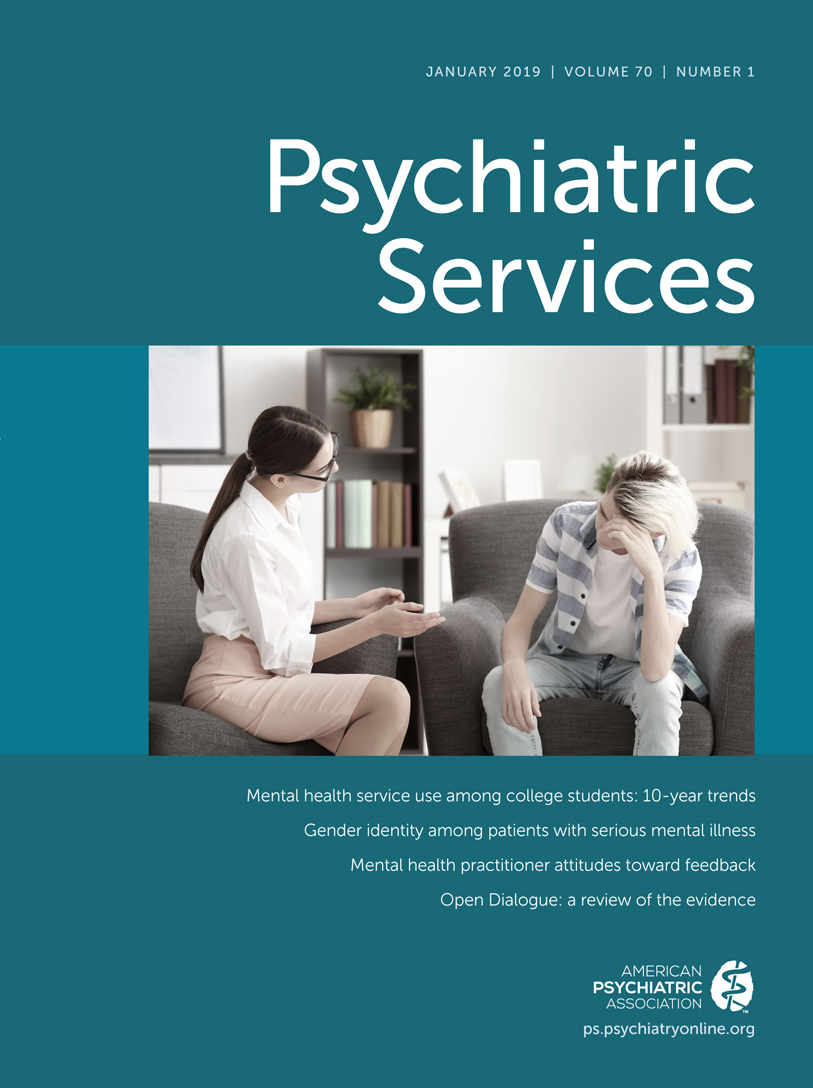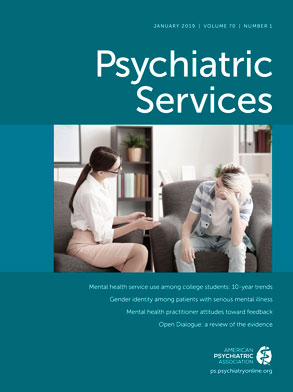Latin America has a long history of moving toward community psychiatry and integrating mental health into primary care (
1). Peru is emblematic of this shift from hospital to community-based care. Following years of political and legislative actions, Peru passed landmark legislation in 2012 guaranteeing the rights of people with mental health issues and requiring mental health treatment and referral services to be available in primary health care centers and general hospitals throughout the country, including in rural areas. In enacting the new law, the Peruvian government approved a 10-year budget to support the implementation and scalability of mental health services in primary care, including screening, diagnosis, and treatment of common mental disorders (
2). Toyama and colleagues (
3) pointed out in a recent analysis of this Peruvian mental health reform that the ultimate success of the reform faces uncertainty, particularly in isolated rural areas of Peru where health systems are weak. As Peru scales up community-based mental health services, both Peru and the overall global mental health movement will benefit from the opportunity to learn from the experiences—both successes and pitfalls—that can inform future efforts.
Mental Health for Development in Apurímac
The pilot project “Salud Mental para el Desarollo de la Región Apurímac,” or “Mental Health for Development in Apurímac,” provides a rich case for extracting lessons in implementing community mental health care in remote areas of low- and middle-income countries. The project, implemented from 2010 to 2014, sought to strengthen capacity for mental health services in primary health centers and regional hospitals in Apurímac—a remote, mountainous region of southern Peru. Between 50% and 70% of households in the region are considered poor, with over one-third extremely poor. The region withstood ongoing violence during the Shining Path conflict between 1980 and 2000. Over a third of the population in the region lost a close family member to the violence, and over a third of those individuals have a mental disorder (
4). An epidemiologic study conducted in 2010 in the region also found that 60% of women experience domestic abuse, another significant risk factor for mental disorders (
5). Piloting a community mental health program in Apurímac was a bold commitment to learning how to implement community mental health care in one of the most high-needs and low-resourced regions in the country.
The program was initiated and funded by Peru’s National Institute of Mental Health and aimed to strengthen the capacities of health teams in primary care clinics and general hospitals in the Apurímac region to carry out promotion, prevention, treatment, and rehabilitation in mental health to benefit the region’s population of approximately 440,000. The Apurímac project followed a five-year timeline. Assessment of intervention need and design spanned the first three years, with a budget of $220,000; implementation took place in years 2–5, with a budget of approximately $10 million; and evaluation took place during years 3–5 and beyond, with a budget of around $300,000.
Basic health teams in the region’s 30 health centers consist of general practitioners and nurses who are meant to refer patients for specialized treatment to five general hospitals in the region. However, these professionals have little or no formal training in psychiatric diagnosis and treatment. Only two rotating psychologists and no psychiatrists served the regional hospitals at the time of initiating the project. To build capacity, the Ministry of Health Technical Advisory Group for the project designed a comprehensive didactic training plan with modules for each level of health worker. Courses included Violence and Depression in Primary Care for basic health teams, Community Based Mental Health Rehabilitation for mental health teams at health centers, and Primary treatment of Psychosis for Hospitals for mental health teams in hospitals. These courses consisted of 28 hours of in-person lecture-based didactics, along with 60 hours of distance learning and practical application. The theory-practice educational approach encouraged participants to incorporate their previous experiences with their new learning to achieve results that would be relevant and could be applied in the real context of their clinical practice.
Following this didactic portion of the capacity-building initiative, a team consisting of 15 psychiatrists, eight psychologists, 10 nurses, and two social workers from the National Institute of Mental Health in Peru carried out an extensive four-year clinical supervision period in the region. Clinical supervision targeted 136 physicians, 50 psychologists, 250 nurses, 150 obstetricians, 25 social workers, and 25 occupational therapists in primary health care centers and general hospitals in the region. Fundamental to this clinical supervision period was a specific effort toward accompaniment. The concept of
accompaniment is found in liberation theology—which has its roots in Latin America—and was popularized secularly in the United States and beyond by the work of the global health organization Partners in Health in the context of HIV/AIDS and tuberculosis treatment by community health workers. Accompaniment implies a step beyond supervision and entails a sense of solidarity and a willingness to “walk with” someone, to experience what they experience and provide support in this way as a witness and coparticipant (
6).
Local health agents in rural Apurímac, as in many low-resource areas, face constant challenges, including the psychological burden of severe resource constraints that inhibit their ability to alleviate the suffering they often witness. In particular, regional health workers have grossly insufficient training and tools to assist with mental disorders, some of the largest contributors to the burden of disease in the region (
4). All too often in global mental health settings, capacity-building initiatives entail fly-in trainings from professionals from major cities, providing limited, short-term follow-up and support at best. Such efforts fall short of catalyzing the true health system strengthening that they seek because they fail to fully support the key health system resource—the health workers. We suggest that accompaniment could be an unrecognized factor in the effectiveness of health system capacity building in the most challenging areas.
The Apurímac project provides a model of clinical supervision in a high-needs remote area that moves toward accompaniment. Training and supervision teams from Lima committed to traveling consistently, month after month, year after year, to rural and difficult-to-access subdistricts far from Lima. The teams flew from Lima to Cuzco nearly each month and from there, drove to Abancay, the small capital of the Apurímac region. From Abancay, they traveled the treacherous mountain roads to each health center to meet with and provide support and supervision to the corresponding health worker teams. Each team of supervisors was assigned to a small group of health facilities in Apurímac for the duration of the four-year project, facilitating the formation of ongoing supportive relationships with an articulated aim of technical and emotional support. The National Institute of Mental Health project’s technical management team, in turn, provided accompaniment and support to the Lima-based training and supervision teams, creating a cascade of supervision and support.
Challenges and Potential Impact
In the larger global health context, engaging local implementers and stakeholders is recognized as important within a framework for successfully scaling up global health interventions (
7). Yet in practice, efforts to engage local partners often fall short because of the extensive energy required to develop engaged and invested partnerships. Another common shortcoming is that partnerships often fail to reach across sectors or engage a sufficiently broad range of actors. One or two highly invested local partners may be enough to catalyze change, but broad support and engagement of multiple actors across sectors and strata of society are required to support the expansion of mental health services, particularly when local leaders and governments change frequently.
To garner community support and form sustained partnerships in the Apurímac region, the Lima-based Peruvian project team conducted a series of meetings with several key groups there. The first step was to meet with directors of the regional government to map the area’s social actors—community leaders, formal or informal, likely to influence community attitudes and actions. Following this joint exercise, these social actors were invited to a meeting led by the regional president and director of social development. This meeting was attended by 51 regional authorities and representatives from 17 local organizations. Together, the participants developed a regional plan for mental health, which articulated the regional and local objectives, described interventions and strategies for improving mental health, and identified the community leaders who would assume responsibility for their implementation (
8). In this way, local authorities were productive participants in the local plans for mental health services expansion.
This concerted effort to seek local buy-in fomented tangible support for the project among regional actors. Notably, involving regional leaders in the planning led to signed commitments to the implementation of the project and to continued implementation of mental health activities in the region.
Despite the strong partnerships built with the regional government of Apurímac, a key obstacle to the success of the program was the lack of coordination and financial commitment from the regional authorities. A planned regional meeting of mayors could have generated a broader level of regional support and commitment, but financing and coordination for this step was not achieved.
Still, local partnerships extended beyond the regional authorities, providing a broader level of support in the region for mental health services expansion. Mental health services in primary care were publicized through local media, including radio and television. Community workers also developed an informative brochure about the project, and flyers were distributed in the community. These activities raised community awareness of mental health services and, in combination with the extended accompaniment period for local health workers by the Lima-based training team, began to weave support for mental health service expansion into the fabric of society and the health system.
When local capacity and awareness are generated in this way for mental health, both from the supply side and the demand side, expansion of services becomes a possibility. In the context of the Apurímac project, the need for enhanced mental health care for pregnant women was identified, and initial steps were taken to adapt and implement Thinking Healthy, a World Health Organization–recommended intervention for maternal depression, deployed among a cadre of community health workers in the Apurímac region. This experience also led to the piloting of Thinking Healthy, which is currently underway in an underserved neighborhood in Northern Lima.
Another challenge to the pilot project, and one that is common to global mental health reform efforts, was establishing mechanisms for coordinating and financing some aspects of the project by the national mental health authorities. As a result, components crucial for the program’s sustainability could not be implemented, including university accreditation for the trainings, financing for data analysis of evaluation components, the creation of manuals, and the design of an information system. Each of these steps would have moved the region toward the continuity and further development of mental health services. In implementation science, cost is a key feature that greatly influences the scalability and dissemination potential of a program. It is common for implementers to define cost only as the amount of money allocated to conduct the program, whereas a more accurate method is to also map the additional resources needed to engage, train, achieve competency, and sustain the delivery and evaluation of the program (
9,
10). In Apurímac, overall resources as well as the resources specifically for implementation could have been enhanced through external partnerships with international organizations interested in supporting implementation research on mental health service expansion, while respecting the plans and priorities established by the National Institute of Mental Health in Peru.

